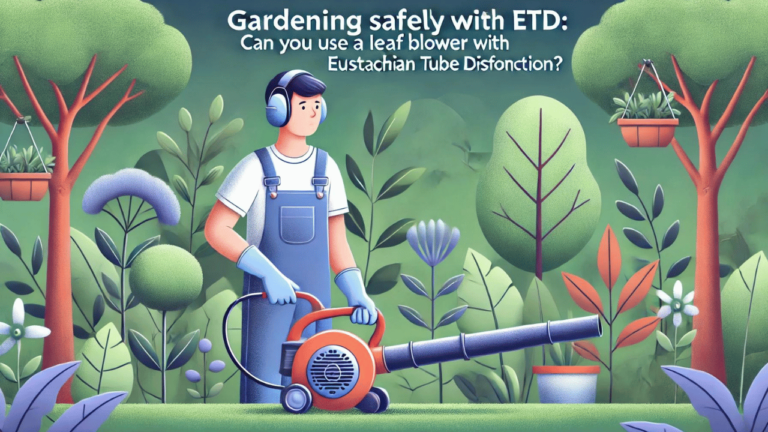Gardening with tools like leaf blowers can be challenging for those with Eustachian Tube Dysfunction (ETD), a condition affecting the ear’s ability to equalize pressure. This comprehensive guide delves into whether using a leaf blower is advisable under such conditions, exploring the impact on ear health and providing strategies to minimize risks.
Understanding Eustachian Tube Dysfunction
Eustachian Tube Dysfunction occurs when the eustachian tube, responsible for equalizing ear pressure, fails to function properly. This can result in symptoms like ear fullness, pain, and hearing difficulties. The question, Can You Use a Leaf Blower with Eustachian Tube Dysfunction, is significant for those needing to maintain their gardens without exacerbating these symptoms.
Risks of Using Leaf Blowers with ETD
The primary concern about using a leaf blower for someone with Eustachian Tube Dysfunction centers on the device’s noise levels and air pressure output. Leaf blowers can emit sounds loud enough to disrupt the eustachian tube’s normal function, potentially leading to increased discomfort or even hearing loss. Understanding these risks is crucial for anyone facing the dilemma of whether can you use a leaf blower wit heusphatian tube dysfunction applies to their situation.
Safe Practices for Using Leaf Blowers
For those who determine that using a leaf blower is necessary, several precautions can help mitigate health risks:
- Opt for Low-Noise Models: Choosing a leaf blower that operates at a lower decibel level can help reduce potential ear strain.
- Use Protective Ear Equipment: Wearing earplugs or noise-canceling earmuffs is essential to protect against high noise levels.
- Limit Exposure Time: Shortening the duration of use can prevent prolonged exposure to loud noise and intense air pressure, which are detrimental to individuals with ETD.
Alternative Yard Maintenance Tools
Considering the challenges posed by can you use a leaf blower wit heusphatian tube dysfunction, exploring alternatives is beneficial:
- Manual Tools: Rakes and manual sweepers provide a quiet, safe alternative to leaf blowers.
- Electric Leaf Vacuums: Some electric models offer quieter operation than their gas-powered counterparts, making them a viable option for those concerned about noise.
Professional Medical Advice
Before continuing or starting the use of a leaf blower, consulting with a healthcare provider is advisable. They can offer personalized advice based on the severity of your Eustachian Tube Dysfunction and your overall ear health.
Strategies for Effective Yard Maintenance with ETD
Given the concerns around the question, can you use a leaf blower wit heusphatian tube dysfunction, here are some effective strategies for yard maintenance that minimize health risks:
- Scheduled Breaks: Incorporate frequent breaks into your gardening routine to reduce exposure to noise and vibrations.
- Collaborative Gardening: Share the workload with family or friends, which not only lessens the time you spend near the leaf blower but also makes gardening a more social and enjoyable activity.
- Professional Yard Care Services: For those who experience significant symptoms, hiring professionals for yard maintenance can be a viable alternative, eliminating personal risk entirely.
Technological Advances in Leaf Blower Design
Innovation in gardening equipment is ongoing, and many manufacturers are now producing leaf blowers designed to be more user-friendly for individuals with health concerns like Eustachian Tube Dysfunction. These advancements include:
- Noise Reduction Technologies: Newer models are focusing on reducing noise output through advanced motor designs and sound-dampening materials.
- Ergonomic Designs: Ergonomically designed leaf blowers reduce the physical strain and vibrations, helping users who may be sensitive to these factors due to ETD.
Community and Support for Individuals with ETD
Engaging with a community of gardeners who face similar health issues can provide valuable support and additional tips on managing ETD while gardening. Online forums, local gardening clubs, and support groups can offer insights and moral support, making the challenge of handling can you use a leaf blower wit heusphatian tube dysfunction less daunting.
Conclusion
The question, Can You Use a Leaf Blower with Eustachian Tube Dysfunction, encompasses concerns about immediate discomfort as well as long-term health consequences. By adopting safer practices, utilizing technological advances in gardening tools, and possibly rethinking yard maintenance strategies, individuals with ETD can continue to enjoy gardening without compromising their ear health.
FAQs About Using Leaf Blowers with Eustachian Tube Dysfunction
- Can using a leaf blower make Eustachian Tube Dysfunction worse?
- Yes, the noise and air pressure from a leaf blower can exacerbate the symptoms of Eustachian Tube Dysfunction.
- What type of ear protection should I use when using a leaf blower with ETD?
- High-quality ear muffs or noise-canceling earplugs are recommended to protect against high decibel levels.
- Are there any particular leaf blower models that are better for someone with ETD?
- Electric models that offer variable speed settings and lower noise outputs are preferable.
- What should I do if I experience discomfort while using a leaf blower?
- Stop using the tool immediately and consult a medical professional to discuss your symptoms and possible adjustments.
- How often should someone with ETD use a leaf blower?
- Limit use as much as possible, and consider alternatives like manual raking or electric vacuums to maintain ear health.


